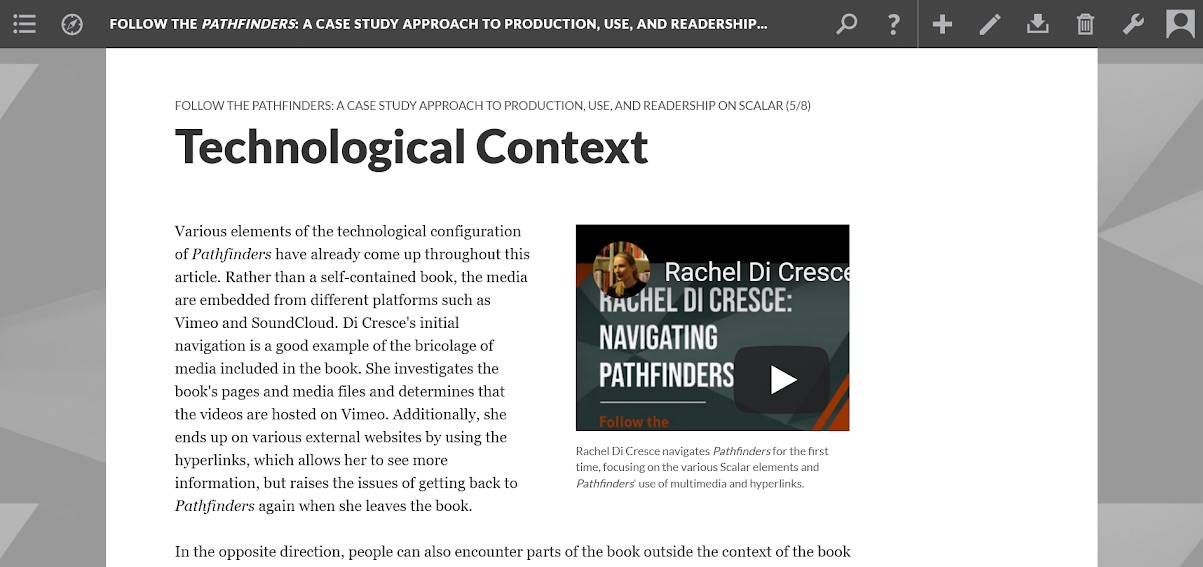Hyperrhiz 24
Follow the Pathfinders: a Case Study Approach to Production, Use, and Readership on Scalar
Hannah Ackermans
University of Bergen
Citation: Ackermans, Hannah. “Follow the Pathfinders: a Case Study Approach to Production, Use, and Readership on Scalar.” Hyperrhiz: New Media Cultures, no. 24, 2021. doi:10.20415/hyp/024.e01
Abstract: This born-digital article examines the multimodal academic publication Pathfinders (Moulthrop and Grigar). Through a combination of interviews with readers and the author, textual analysis of the book, and literature review of Scalar, I trace the affordances of the platform, appropriation by scholars, the media text, and readership of Pathfinders. I distill themes that are key in the multimodality of the book, including platform adoption, institutional embedding, technological context and research values. Throughout the article, which is also written on Scalar, I reflect on my own use of Scalar and the various considerations that come with it in terms of software sustainability, accessibility, and transparency of research context. I conclude with a reflection on the media specificity of Scalar as an academic platform.
Keywords: media specificity, multimodality, Scalar, electronic literature, academic publication platform.
View Project: VIEW Project: Follow the Pathfinders
About the Project

Following the increasing use of hypertext in digital culture over the past decades, reinventing the medial mode of academic publication becomes desirable to open up new research practices and knowledge production. New digital platforms are taking practice-based steps towards more multimodal publications. This article examines the born-digital book Pathfinders: Documenting the Experience of Early Digital Literature by Stuart Moulthrop and Dene Grigar which was published in the humanities publication platform Scalar. In Pathfinders, four classic works of electronic literature are documented using a combination of Traversals (filmed walkthroughs by authors and readers), filmed interviews and carefully described and photographed physical materials. As such, Pathfinders is positioned as a DH practice to “rescue” early works of electronic literature from both technological obsolescence and oblivion.
Using the ‘Follow the Thing’ method, I trace the various stages in the publication to induce the themes that are important for born-digital publications. The first stage is the technical platform Scalar and its technological affordances. The second stage is the scholars’ adoption and appropriation of the platform for their own purposes. The third stage is the media text, the born-digital book publication, and its media-specific arguments. The fourth and final stage is the reader’s experience of the multimodal book.
Through a combination of interviews with readers and the author, textual analysis of the book, and literature review of Scalar, I distill the key aspects of multimodality of this publication. The first theme is the adoption of Scalar. Here, I focus on the technological affordances of Scalar in relation to the use of Scalar by the authors and readers of Pathfinders. This includes a discussion on software sustainability in terms of labor as well as a media analysis on the 'bookishness' of the work. A second theme that arose is the implementation in institutional and academic publication structures. Previously mainly researched in the context of digital pedagogy, I take this to a new level by considering how Pathfinders has fared as a pivotal publication in the field of electronic literature and the role of accessibility in its functioning as an academic resource. Third, I focus on the technological context, which includes a reflection on the embedded media as an iteration of the metainterface paradigm and the role of documented physical materials in the understanding of early electronic literature. Finally, I discuss the theme of documentation and publication as a research value. Pathfinders is a prime example of the argument that documentation needs to be at the center of research on ephemeral media, using Scalar's tool and functionalities to highlight this in the book. I take my analysis of Pathfinders to conclude with a reflection on the media specificity of Scalar as an academic platform.